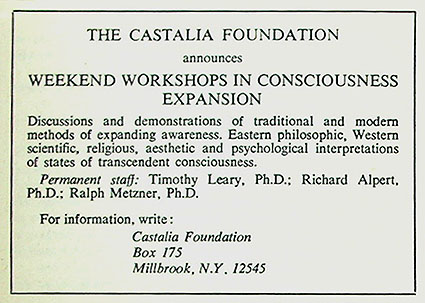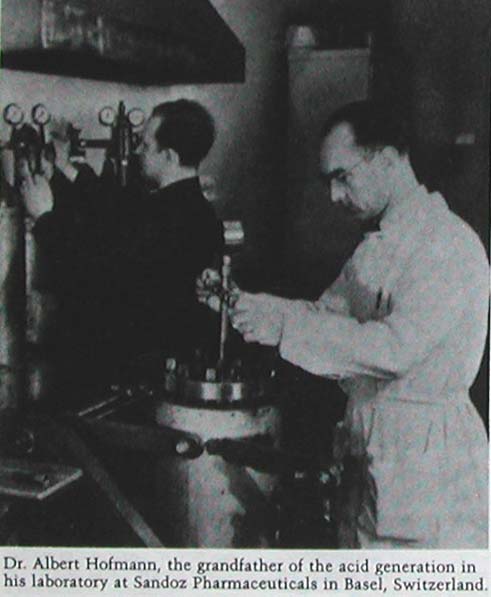|
Acid Dreams, by Martin A Lee and
Bruce Shlain (1986)
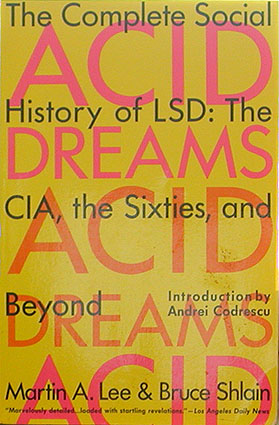
This well-received title was partly triggered by the
availability of previously secret CIA files concerning the MK-ULTRA project
during the 1950s.
The authors build their full chronology around this remarkable material,
with the chapters on what happened before and after being somewhat less
impressive, often based exclusively on previously known works. Still,
entertaining and with a cool attitude that undoubtedly help foster its
popularity among newer generations of acidheads. 345 pp. Currently in print.
http://www.levity.com/aciddreams/
Storming Heaven,
by Jay
Stevens
(1987)
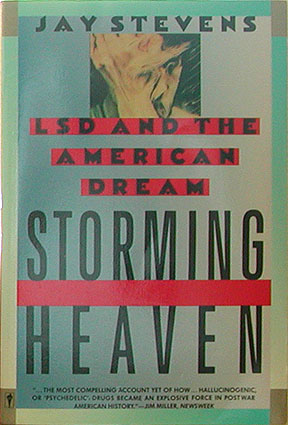
Stevens' thunder
was partly stolen by Acid Dreams (above) which appeared shortly before and
covers much of the same ground. This is clearly the better of the two, with
a serious, confident tone that helps the reader realize the magnitude of the
LSD revolution as one of the more important events of the 20th Century.
Chapters on the founding fathers and early days (1930-50) are particularly
impressive, with lots of unique source and interview material. This should
remain the standardwork in the field. Used copies are easy to find on eBay. 416
pp. Currently in print.
Millbrook,
by Art Kleps
(1977)

This book, by the
founder of the Neo-American Church (registered in 1965 as the first acid
religion anywhere), is a rather amazing roller-coaster ride detailing not
only the bizarre menagerie and intrigues at Millbrook circa 1966-68, but
also the unusual psychedelic-solipsist philosophy of the Chief Boo-Hoo. The
book cannot be summarized in a few sentences but should be read by anyone
interested in psychedelia. Not all of it is appealing, some of it
lamentable, but on the whole Kleps appears like an inspired, hilarious and
occasionally brilliant observer of people and their habits. Everyone
including Kleps himself comes out looking like an egomaniac schmuck, though
the sharpest poison is spared for Timothy Leary who seems to have been a
spectre haunting Kleps solipsist dreams, judging by the amount of textual
space spent on the mentor-turned-traitor. From a purely lysergic perspective
Kleps deserves applause for his determination to describe and explain the
LSD trip for what it is, not as a metaphor or part of "something
else". Kleps passed away in 1999, 71 years old.
The original book is somewhat difficult to find, having not been reprinted after the
first run in the mid-1970s. Both hardcover and softcover versions exist. No
images. 355 pp.
I haven't ordered and can't vouch for it, but the Boo-Hoo Church or
affiliated parties offer copies of the
book via print-on-demand.
The
Boo-Hoo Bible, by Art Kleps (1967-1972)
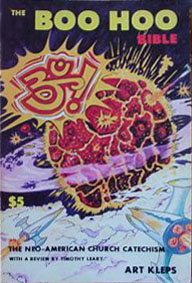
This is Kleps' most
famous work, a highly unorthodox "catechism" for his hallucinogen
church consisting of an assortment of "Divine Toad Sweat"
newsletters from the very earliest days (1965) and onwards as well as
newspaper clippings, senate committee hearings, excerpts from law-books, and
random essays on whatever was on Kleps' mind. It works well as a whole, and
is an essential piece of psychedelic history, although one may wish that
Kleps would have spent more time explaining the hows and whats of the acid
trip (his true forte) and less on iconoclastic outbursts. His arch-nemesis
Tim Leary contributes a double-edged appraisal of the book in an appendix.
The contents differ between different editions of the book, which was first
published as "The Neo-American Church Catechism" in 1967. Somewhat easier to find used than "Millbrook". 220 pp.
Like
"Millbrook", the Boo-Hoo Bible can still (in 2013) be
ordered directly from the Neo-American
Church.
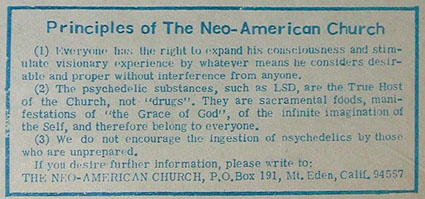
Ad in the L A
Oracle, Summer 1967
LSD - My
Problem Child,
by Albert Hofmann (1980/2007)
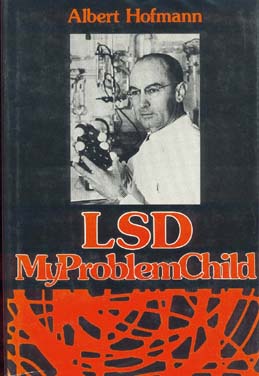
The
distinguished, somewhat reluctant, yet always optimistic and openminded grandfather
of the psychedelic revolution speaks. Original hardcover copies command high
prices, but the softcover should be findable.
There is now (2007) a new
English translation available, with some recent photos added. Hofmann is an
intelligent, dignified man with a lifelong openness to the mystical
experience, despite his impressive scientific background. We're very
fortunate that it was he and noone else who ran across the effects of
derivative # 25 that legendary day many decades ago. No doubt thanks to the
occasional tasting of his own discovery, Dr Hofmann went onto become 102
years old, before passing away in 2008. Essential reading. 210 pp.
The
Varieties Of Psychedelic Experience,
by REL Masters and Jean Houston
(1966)
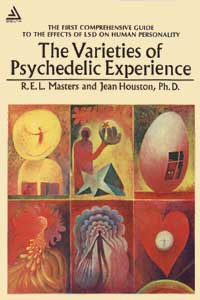
One of the standard
works of the field, a serious and well-written overview of all the various
aspects of the LSD/peyote experience, presented via a series of descriptions
of actual trips that were guided by the authors. Early enough to be free
from borh cosmic new age-ness and square hysteria, yet late enough to
present a sort of definite picture. Does not attempt to squeeze acid into
some existing religious/psychoanalytic framework but takes it just for what
it is, which means that the book has aged well, and indeed has been
reprinted not long ago. Despite the academic tone, not without a sense of
humor, and many of the trip reports are amazing. An impressive tome, and the
book I would most recommend as reading prior to your first lysergic
journey. 326 pp. Currently in print.

Psychedelic
researcher
Jean Houston. Photo by Don Snyder.
Psychedelic
Art, by REL Masters and Jean Houston (1968)
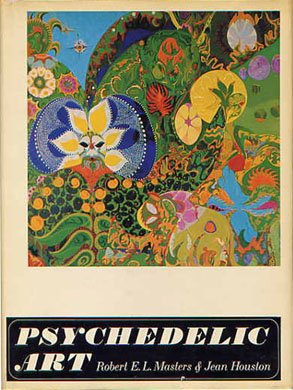
To this day the only
book published on this crucial subject, a highly interesting work both for
its visual and literary contents. The authors provide plenty of context and
background for the psychedelic art scene of the time, linking it both to
earlier art schools such as surrealism as well as to the direct impulses
from the psychedelic experience. Several artists are presented with full
color and black & white plates, although one might object to the
use of the latter, as the colors are such a vital part of this art. Stanley
Krippner expands on the acid aspect, while additional comments on the
artists and the scene are given by Barry Schwartz, who also provides a very
useful definition of the genre.
The book is rather NYC-centric and manages
to miss the west coast poster scene almost entirely, but since that has been
covered so well elsewhere it's no great loss. I'm not sure how much success
any of the LSD artists presented did achieve, and of course the scene as a
whole never reached the lofty heights speculated upon in this book, which
makes it seem more of an "underground" experience in retrospect.
Psychedelic art of a substantially higher quality than what is seen here
would be produced from the 1980s onwards by artists such as Alex Grey and
Pablo Amaringo.
Never reprinted and somewhat hard to find. Hardcover with dj. 190 pp.
The
Joyous Cosmology, by Alan Watts (1962)
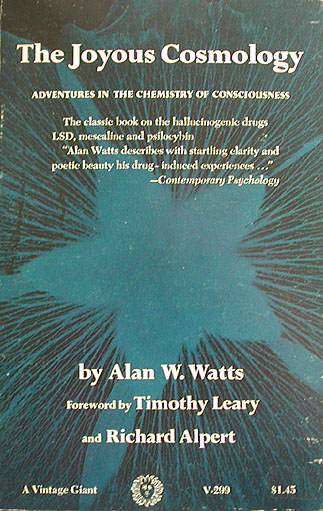
One of the
classics of the field, with the legendary Alan Watts recounting lessons
learned from his early 1960s LSD trips in a style just as eloquent as his
famous radio lectures. Comparable to "The Doors Of Perception" but
at least to me superior; less entangled in pre-existing learning and more
open to the experience itself. Watts' conclusions from the LSD insights are
surprising and individualistic, and do not necessarily conform to the
Eastern-oriented school of thought he usually propagated. Contains a famous
aural trip through a christian mass with organ music which is as good a
summary of the acid experience as you can find. A must read, sort of like
the Rolls Royce of trip journals. Illustrated with photographs of
natural phenomena whose psychedelic nature is brought to light, cool
concept. Original softcovers are fairly easy to find and sport an intro by
Leary & Alpert from when they were just two renegade Harvard scientists.
94 pp.

Alan Watts also recorded a little known LP titled "This Is IT"
around this time, which is of equally great significane. Read all about it
and its connection to "The Joyous Cosmology" here.
LSD
- The Consciousness Expanding Drug, edited by David Solomon (1964)

This collection of
essays and articles became one of the best-selling LSD books of the 1960s,
and the later printings are easy to find. It was conceived at a time when
psychedelic research was still mainly an academic concern for shrinks and
MD:s, which means that the tone is rather dry and technical. However the
list of contributors is very impressive: Aldous Huxley, Alan Watts, Timothy
Leary, William Burroughs, Humphry Osmond (R.I.P); a virtual who's who of the
original scene. Editor David Solomon went on to new adventures as author of
"The Marihuana Papers" and hands-on involvement with the
"Brotherhood Of Eternal Love" in the 1970s.
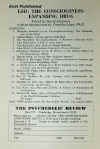
Ad for
Solomon's book in
the Psychedelic Review #4 <clickable>
Golden
Guide To Hallucinogenic Plants (1976)
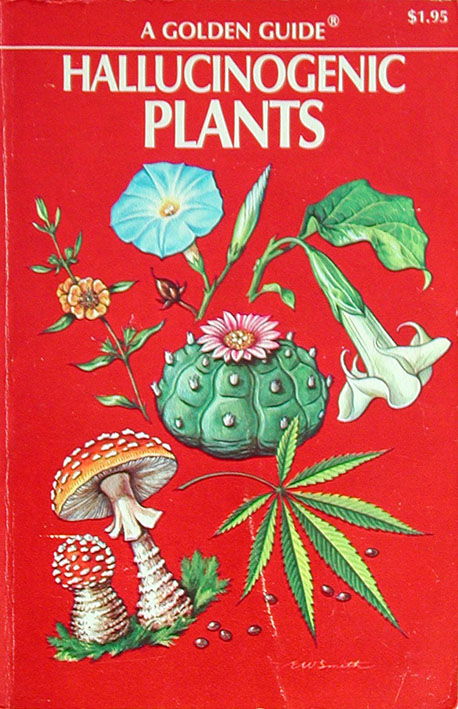 
Pretty unbelievable field guide in
the well-known 1970s "Golden Guide" series, the difference being that this
one covers hallucinogens. Made either as one of
the most brilliantly subversive pranks of the era, or in all honesty by geek
scientists unaware of the implications. Either way it's a must-have for any
respectable drug library, and a beautiful little volume too with color
drawings of psychedelic plants from all corners of the world and a learned
text by renowned authority Richard Evans-Schultes. LSD and DMT are covered
as well. Impossible to imagine happening today, and indeed too heavy even
for the liberal 1970s, which caused its withdrawal and relative scarcity.
The hardcover variant in bigger format is even rarer. The image above is clickable. 160pp, massively illustrated.
Moksha
- Aldous Huxley's Classic Writings on Psychedelics and the Visionary
Experience, edited by Michael Horowitz & Cynthia Palmer (1977)
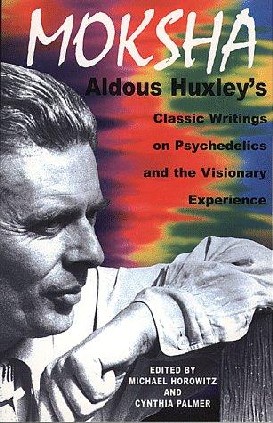
While Huxley's
"Doors Of Perception" from 1954 is the single most famous book on
the subject of hallucinogens, this anthology of essays, lectures and letters
is a better introduction to both the field and Huxley himself. It appears
that Huxley wrote "Doors" (and its sequel "Heaven &
Hell") before his thoughts on the matter had fully developed, as
they would in the late 1950s.
Some of the items in "Moksha" are
truly brilliant and apart from being superior writings on the subjects of
hallucinogenic drugs, personal freedom, and spiritual search, also show what
a tremendous intelligence Huxley possessed. In addition to Huxley's own writings
we also get selected pieces from Humphry Osmond, Tim Leary and Laura Huxley
for intriguing glimpses of the man from the outside. Currently in print. 270
pp.
The
Man Who Turned On The World, by Michael Hollingshead (1973)
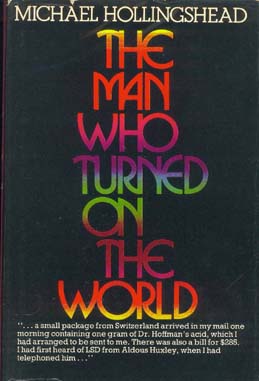
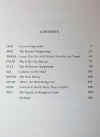
British-born globetrotter
Hollingshead is one of those enigmatic characters who appear at different
places in psychedelic history, doing important work at crucial junctures,
yet remain very hard to figure out. This autobiography covering the
1961-1970 years doesn't really offer much insights into the man himself,
except a certain restlessness and recklessness not unlike that displayed by
Art Kleps.
The first 1/3rd, detailing the embryonic years of wild research
trips in New York and Boston is by far the best, well-written, clever and
revelatory. Apart from his work in the Harvard circles (including giving
Timothy Leary his first LSD trip), Hollingshead set up a New York-based
project of his own together with Jean Houston, where lots of guided trips
were performed and data gathered, forming the backbone for Houston's
"Varieties Of Psychedelic Experience" (see above). This
"Agora" project is not very well documented elsewhere, and alone
makes the book worth reading.
As Hollingshead returns to England
in 1965 the storyline becomes increasingly erratic. The very important work
performed there as dozens of famous British artists and musicians were
introduced to LSD is described in only vague terms, and based on
Hollingshead's own testimony it may be that his heavy use of amphetamines
means that he simply doesn't remember much. After he was busted he was sent
to a British prison in 1966, from which the memories seem to be clearer and
occasionally quite interesting, though the narrative is abruptly cut short.

Michael
Hollingshead outside
the Harvard building where he
gave Tim Leary his first LSD trip.
Photo by Don Snyder... apologies
for the poor scan job.
The last third of the book finds
Hollingshead on the hippie trail, making stops in Norway, Tonga and Nepal
and engaging in various local projects while getting stoned constantly.
Visits with Tim Leary and the Brotherhood Of Eternal Love on the US
westcoast could have been interesting but have a superficial, postcard-like
feel. It all reads much like any backpacker memoir from the era and the
ground-breaking, ahead of the pack nature of the early 1960s chapters is
sadly missing, and the book as a whole sort of fizzles out. Hollingshead
current whereabouts are (of course) shrouded in mystery, although it appears
he may have died in South America in the late 1970s. He did write a few more
things in the 1970s.
The book is a bit of a mess, with extensive quotes that have no attribution
whatsoever, often not even author. Footnotes appear briefly on a few pages,
then disappear again. There's also signs of poor proofreading. In any event,
and despite the weak 2nd half, this book appears to be liked by many but is
somewhat difficult to find. No images. 250pp.
Explorations
In Awareness, by John W Aiken (1966)
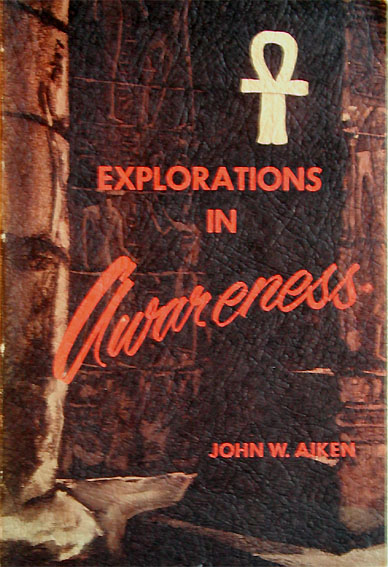 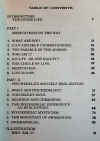
Although John Aiken and his wife
Louise have an obvious place in the psychedelic chronicles, their story is
poorly documented. They were MD:s by profession and in the later years of
their lives retired to New Mexico for spiritual research, with and without
psychedelics. Art Kleps has credited their Church Of Awakening as being the
very first non-Native American psychedelic church to be registered (1963),
predating both Kleps and the Millbrookers by a couple of years.
This slender
volume, sporting a great cover that looks like a 1950s exotica LP, is a
delight to read. Obviously drawing on a vast array of ancient and modern
sources, Aiken presents an esoteric doctrine of self-realization and
ultimate transcendence, told in a pure, stripped-down style that displays
selfconfidence and insight. It is not a rehash but a new psychedelic path,
with vedic-yogic as well as Christian and Native American influences. The
latter chapters contain a couple of trip reports, including one from a
(presumed) Indian guru, who does a respectworthy attempt to squeeze the
cosmologic-metaphysic experiences of an acid trip into plain English.
Written mainly in 1963, Aiken's LSD vibe is very different from what would
follow, and deserves much greater recognition. The book may require some
search, although I was actually given a copy for free by a generous fellow
traveler. 85pp. A few drawings.
Aiken
also appeared with an article in Fate magazine in 1963, discussed elsewhere on
this website.
Aquarian
Odyssey, by Don Snyder (1979)
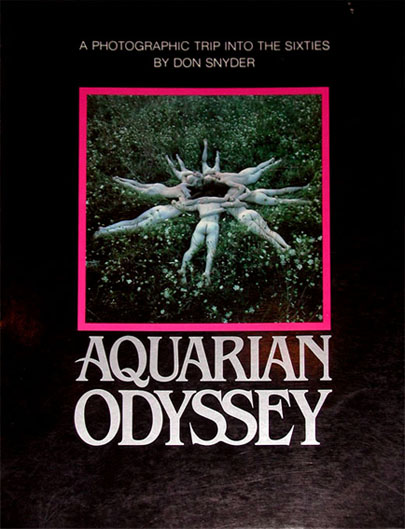
This is one of the best photo books
I've seen about the hippie era, a true delight for anyone wanting to
understand what the Freak Revolution was really about. Snyder goes into some
long, technical explanations about his method in the very interesting
foreword; I only understand about half of it but the outcome is terrific. The
colors are warm, the people seem very alive and present, and there's a sense
of coherence. Many of the photos are obviously posed, yet done so in a way
that looks very natural -- no small feat. The actual subjects is a mix of
street freaks, occultists, rock'n'rollers, performance artists, and a host of
famous scenemakers such as Ram Dass, Leary, the Dead, Allen Cohen, etc. The
coverage is geographically divided between New York City (like shots inside
the famous Electric Circus), rural communes in New England, and the San
Francisco Bay Area.
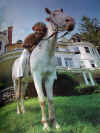
Tim
Leary at Millbrook.
Photo by Don Snyder.
There is a certain timelessness to the photos -- the people don't look like
"60s" people as much as outsiders and explorers from pretty much any
area. A lot of it could stem from 2007 as much as 1969. This is a pleasant
change. The other thing one might notice is that there's a certain melancholy
that permeates the volume, one which probably derives from it being a
retrospective work, assembled in 1979 when the 60s and hippies were fading
into the past. The book isn't too hard to find, and recommended. Color plates
throughout. Unpaginated, c 110p.
Brotherhood
Of Eternal Love, by Stewart Tendler & David May (1984 / 2007)
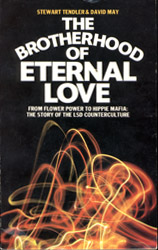
1984
edition
Something of a classic within LSD literature, this book was a hard-to-find
collectable for many years, until the recent edition appeared (Cyan Books).
Written by two British journalists, the main focus is on the LSD manufacture
and distribution during 1965-1978. The Brotherhood of the title was a group
of idealistic heads in Southern California who began distributing Owsley
acid for free and within a few years found themselves in an international
drug smuggling network. This story is fairly well-known (Rolling Stone wrote
about them in the 70s), while the other main focus of this book is less
well-documented; the British-based manufacture and dealing of LSD in the
1970s. A massive police effort called Operation Julie busted the whole scene
open, and even led to a full-length movie. Overall LSD and hippie culture
history is also covered in passing. The subject matter is interesting, but
the writing is somewhat disengaged in a magazine fashion, and the cast of
characters so massive that it's hard to keep track of who did what. Still, a
vital read on the mid-period history of hallucinogens, when it became big
business. 270 pages, with b & w photo section.
The
Invisible Landscape, by Terence McKenna & Dennis McKenna (1975)
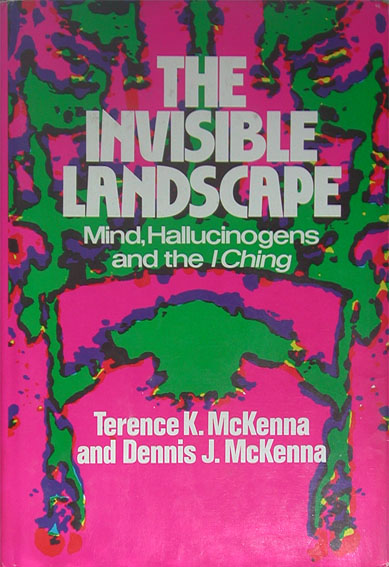
Terence McKenna should need no introduction to psychedelic explorers. Once
introduced by Tim Leary as "the real Timothy Leary", McKenna
became the great hallucinogen ring-leader from the late 1980s and onwards,
thanks in no small part to his amazingly eloquent lecturing. The resurgence
of psychedelic culture and research in the 1990s was facilitated by a break
with the earlier (1950s-60s) era, a paradigm shift which was undoubtedly
partly deliberate and to which McKenna contributed a great deal. One
important aspect to the move forward was a re-focusing of the substance
interest, from LSD to organic, shamanic highs such as psilocybin mushrooms,
ayahuasca and DMT. This is the phase we're still in today (2007).

McKenna's first book, co-authored with his brother Dennis (b. 1950), is a
rather dazzling read. Inspired by a life-altering trip experience in the
Amazon jungle 1971, the authors come off somewhat like maverick graduate
students. The book aspires to much, and takes a cross-scientific approach to
launch a new view of consciousness and what we call reality. As with much of
McKenna's work, there is a sense of scientific parody, or tricksterism, even
as the formal and technical aspects of the theories are comprehensive.
Taking various cutting edge (at the time) theories and discoveries from
fields such as neurology, biochemistry, quantum science and stringing them
together, a complex hypothesis about the relationship between organic
plants, perception and evolution is presented. The technical sections
occasionally can drag on, unless you're engaged in the field yourself, but
the energy and barrier-breaking is compelling. The second part of the book
details McKenna's "Time Wave Zero" theory, an extrapolation of
hidden structures in the I-Ching which you can read more about on the Net.
An appendix of Fortran computer program print-outs make for a charming retro
feel today, but the work otherwise has aged well and is a must-read. 230 pp,
some illustrations.
This review refers to the original 1975 edition (shown above); a later
revision exists.
PS read more about an important early McKenna
work here.
DMT - The Spirit Molecule, by Rick Strassman
(2001)

First published in 2001, this is the most recent work to be featured in
these pages, and it is indeed a modern classic within hallucinogen
literature. After some skillful manouevring through the bureaucratic and
legal mazes of US drug research, Strassman conducted the first formal
academic study of D.M.T with human subjects in several decades. Not only
that, but it was a major study with many dozens of research subjects,
running for five years at the University of New Mexico. Strassman obviously
belongs to the illuminated among us, and was fully aware of the further
implications of his work, beyond the immediate neuro-biological and
psychological interest. There is an obvious personal commitment to the work,
which colors the tone of this book. Old enough to belong to the original
hippie generation, the author occasionally displays a naiveté that some
might assume we'd left behind us in the 1970s, although this doesn't really
affect the central themes of the book. The unguarded honesty, both personal
and professional, instead becomes an advantage as series of extraordinary
DMT experiences are discussed, conclusions drawn, and methods refined. It is
an impressive work research-wise, and the descriptions of the academic
milieu and factors contrast nicely with the outlandish trip reports.
For the full story on DiMethylTrytpamine, generally recognized as the most
powerful psychedelic in the world, you will have to look elsewhere.
Putting Strassman's findings against the many other reports available (not
least from Terence McKenna), there are some interesting differences. The
"elf" encounter theme is less expressed, and instead it seems to
be circus clowns, jesters and the ubiqutous insectile aliens that dominate
the DMT reports. The differences can probably be explained, at least in
part, by the clinical environment in which the experiments were performed.
There are also reports of visits to other planets, travel through space and
in time, death/rebirth experiences, and so on. DMT tends to generate more
interesting trip reports than other hallucinogens, thanks partly to the
condensed and intense nature of the experience, often producing a sense of
wonder and marvel among readers... especially since so many experiences are
similar in both structure, contents, and emotional tone. What can we make of
the fact that so many different people report almost identical trips and
encounters with beings and foreign dimensions under DMT ?

Rick Strassman offers no immediate answer to this very vital question,
except for some loose speculation about dark matter and alternate dimensions
towards the end of the book. Anyone hoping for "The Spirit
Molecule" to solve the mystery of the DMT experience will be
disappointed, and Strassman's conclusions seem more occupied with other
issues. None or few of his research subjects displayed any marked change in
their lifestyles or activities, despite the reportedly life-altering
experiences they had had under DMT. Over time, the trip seems to fade away
and become another memory. To this interesting finding one might object that
all Strassman's subjects were experienced users of LSD, psilocybin and even
DMT beforehand (this was a selection criteria), which means that they had
already been through the main door, and had already changed their lives as
much as they would. Adding some DMT trips on top of this background doesn't
necessarily change much.
In any event, from this somewhat disappointing end result as well as a
conflict with a local buddhist organization who disapproved of their
member's work on hallucinogens, Strassman ended his long research project on
a slightly disillusioned note, but the reader might feel that this is more
connected to personal factors than the quality and outcome of the study,
which is remarkable and important. After this project, Strassman took an
interest in near-death research and alien abduction phenomena, both of which
may be related to dimethyltryptamine, which occurs naturally in the brain;
according to Strassman's theory DMT is produced or facilitated by the pineal
gland.
This is a must-read, and comes with a very attractive Alex Grey-designed
front cover. 350pp. The book is currently in-print and easy to find. You can
even get a signed copy directly
from the author.
Lysergic
Acid Diethylamide and Mescaline in Experimental Psychiatry, edited by
Louis Cholden, MD (1956)
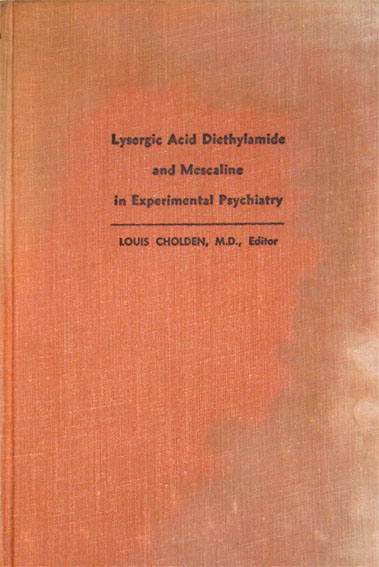
This
slender volume is the earliest work listed in Peter Stafford's selective
reading list of psychedelic literature, and of some historical importance.
By and large it's a technical volume for branch professionals within
psychiatry and psycho-pharmacology, but being LSD and being the 1950s, a
tone of exploration and slight wonder creeps into many of the pieces.
Rounding up about a dozen papers presented at the annual meeting of the
American Psychiatric Association in Atlantic City on May 12 1955, several
familiar names appear among the participants.
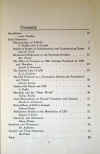
Dr
R A Sandison who pioneered "psycholytic" therapy in London submits
a charming 7-page article on his research, while Abram Hoffer gives a brief
report from the massive psychedelic work conducted by him, Humphry Osmond et
al up in Saskatchewan. To stir up some action, the APA had invited no one
less than Aldous Huxley, whose "Mescaline And The Other World"
(reprinted in 'Moksha') extends themes from his recent books on
hallucinogens, and indicates where his future focus would lie, as heard on
the later "Visionary Experience" LP lecture. I also found Charles
Savage's piece on transactional aspects of LSD therapy very interesting, not
least because it discusses the terms set and setting, much later made famous
by Timothy Leary. Savage also displays what must be one of the earliest of
psychedelic art in a printed book, and it comes complete with a
psycho-analytic "explanation" of its meaning. See scans.

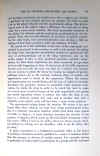
Some of the other articles deal only with technical aspects, and there is a
marked interest in the psycho-tomimetic approach to the mystery
of schizophrenia, a line of research which was later abandoned since the
similarities between the LSD trip and schizophrenia were superficial and
inconclusive. Overall a very interesting peek into the early days of
lysergic research. 82 pp, a few b & w illustrations.
Realms
Of The Human Unconscious by Stanislav Grof (1975)

Stanislav
Grof is one of the major names in modern psychedelic research. Although his
first work -- this -- wasn't published until the mid-1970s, his experience
in the field reaches back to the early 1960s, when he was involved in some
major psychiatric LSD studies in his native Czechoslovakia. Grof moved to
the US in 1967 and continued his research, to the extent that the
anti-psychedelic backlash allowed it.

"Realms Of The Human Unconscious" draws on a huge number of cases
that Grof handled in his early research, to present a number of observations
and theories that he developed from these. Detailed case reports are
presented in a way similar to "The Varieties Of Psychedelic
Experience" (see above), but these are also abstracted and generalized
into Grof's ideas about consciousness. The main theory concerns pre-natal
and birth experiences, which Grof feels are crucial to the subject's later
development and, in some cases, psycho-pathology. Four different types of
Basic Perinatal Matrices are identified and mapped against a number of
clinical cases and LSD experiences. These "personality" scenarios
are described as being played out over and over in life, especially in
traumatic or difficult situations. Such a recurring structure is what Grof
calls a COEX, or system of condensed experiences, which consists of layers
of iterative and possibly self-reinforcing behavior patterns, which are
tracable back in time, ultimately to the original birth or pre-birth
trauma.
This may all sound more like Freudian psychodynamics than LSD research, and
to whatever extent my summary above is accurate, these theories are the main
product of Grof's book. However, from a purely psychedelic perspective, the
individual case histories and Grof's initial observations about the nature
and characteristics of the LSD experience, may be even more interesting than
the psychological models he presents. The time and place provide several
cases with an unusual content, as they draw on experiences from WWII and
nazi occupation. As often, it's a valuable and often mindboggling read. It
should be mentioned that Grof here worked according to the European
psycholytic model, which means a series of LSD sessions using relatively
small doses, as opposed to the American psychedelic model which works with
very few (often just one) high-dose LSD experiences.
This is not a pop-science book, but seems to be aimed primarily at Grof's
peers in the psychiatric community. The clinical tone may be off-putting to
some, although the intelligence and clarity at play is refreshing. The
scientific approach also thankfully rids us of the usual moralistic
handwringing, and shows that much larger issues are at stake.
Grof would publish many more works in the field, but this classic work is a
good place to start. 246 pp, lots of b & w illustrations (mainly therapy
drawings). Reprinted several times.
The
Cosmic Serpent by Jeremy Narby (1998)
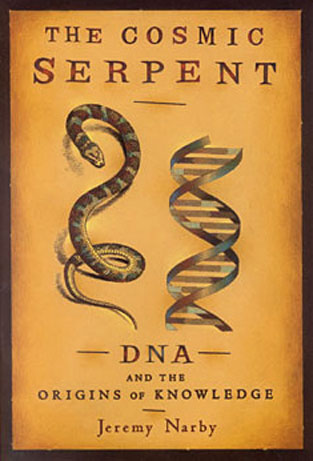
Narby is a Swiss-Canadian anthropologist who first published this book in French in
1995. It appears to have made more of a splash than psychedelic-related
titles tend to do, and if approached the right way it is an interesting
read. Starting from an ayahuasca (a k a yage) experience he had in Peru and
some intrigung comments about plant knowledge from a local ayahuascuero,
Narby embarks on a long quest to understand the workings of this remarkable
plant drug, and how it may have shaped native consciousness in the Amazonas.
The writing style is somewhat unusual, and the text deals more with Narby's
detective work and his reflections upon the limits of modern science, than
on his actual findings.
The basic theory is that a hallucinogenic plant drug such as ayahuasca
facilitates direct communication with knowledge embedded in human DNA, which
if properly unlocked would make incredible amounts of data and experiences
(reaching back to pre-humanoid eras) available. This, Narby argues, has also
affected the mythologies of the aboriginal peoples who have used ayahuasca,
where traces of the DNA structure can be found in the forms of motifs of
twin snakes in water, and so forth. In other words, DNA itself has
communicated with these people over the centuries, and made itself part of
their history, in addition to giving them extraordinary knowledge about
nature.
This is not an academic work, but pop science or fringe science. It's easy
to find problems with Narby's research and conclusions (see Amazon.com
reader reviews for the most obvious objections), yet I believe most psychedelic
researchers would agree that the author is on the right trail. Extraordinary
and inexplicable things await in the deep hallucinogen
experience, and they often seem to point towards those domains that Narby is
examining.
As a side-note, it's somewhat odd that he fails to fully recognize the
similar (and much more elaborate) theory presented by the McKenna brothers
in "The Invisible Landscape" (see above), or the 8-circuit model
of the neural system that Timothy Leary launched, in which communication
with DNA is one of the highest states.
It's also interesting to note that this entire project of Narby's, which
took up many years of his life, came about essentially as an effect of one
single ayahuasca experience. The book has several b & w images. The main
text is 160 pp, with an additional 80 pages of notes and bibliography. It's
currently (2008) in print.
Breaking
Open The Head by Daniel Pinchbeck (2002)
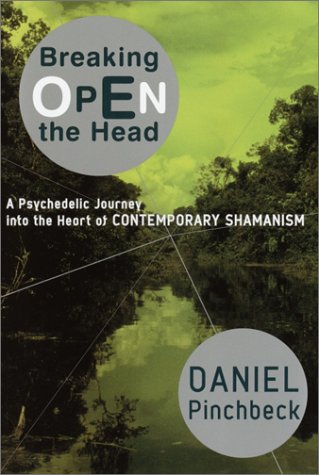
Like "The Cosmic
Serpent" above, this 'psychedelic journey into the heart of
contemporary shamanism' has raised interest outside the usual hallucinogen
research circles, and is another vital piece in the post-McKenna reemergence
of psychedelic culture. Pinchbeck's book is somewhat uneven and occasionally
reads like an anthology of articles for Wired or Rolling Stone, rather than
a coherent work.
Understanding the need to find a niche within the crowded field of entheogen
prophets, he shrewdly opens with an account of a trek to Gabon to partake in
an Iboga ritual, which has been poorly documented elsewhere. From this
profound and well-written experience, the journey continues to various head
scenes in both modern western and aboriginal cultures. A substantial part of
the text is taken up by recaps of psychedelic history and thus familiar
ground for many, although the author has done his homework well enough to
come up with some rarely discussed details, and raises some valid points.
The recurring invocations of Walter Benjamin may look trendy, but work well.
Unfortunately, the predilection for journalese writing and dogmatic stances
on a few complex issues (such as Timothy Leary) bring in an unpsychedelic
feel which in turn raises questions of just how committed Pinchbeck really
is to his quest. The comments on 60s psychedelic music are just shallow and
uninformed, and there's a strange New York-centric view whenever that
cultural era is brought up.
This book probably works best for bored Generation X-ers and former yuppies
looking for experiences that are truly unusual. Armed with "Breaking
Open The Head" they should be well-prepared for their next $500
ayahuasca ritual, and they can build a large reading list from Pinchbeck's
many useful references. 300pp, no images.
Center
Of The Cyclone by John Lilly (1972)
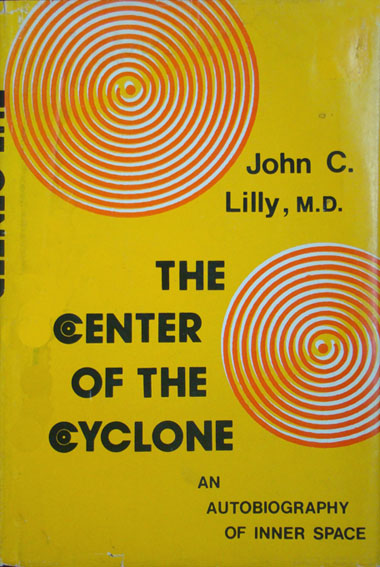
John C Lilly (1915-2001)
is one of the legendary names in psychedelic history, a formally trained
scientist whose creativity and fearlessness led to significant breakthroughs
in areas such as dolphin research, sensory deprivation (Lilly invented the
saltwater isolation tank), and concsciousness models. Ken Russell's cult
acid movie "Altered
States" is heavily influenced by Lilly's work.
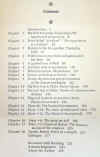
"Center Of The Cyclone" is Lilly's key psychedelic work, written
after a period of experimentation with LSD and other conciousness modifiers.
The book starts out in an impressive and engaging manner, as Lilly recounts
his early LSD experiences, inside and outside the isolation tank. Trying to
understand and gain perspective on his acid trips, he visits Esalen
Institute a couple of times, and also undergoes hypnosis repeatedly. These
experiences do not really illuminate his hallucinogen visions, yet are
described in great detail. As the book progresses, Lilly's focus becomes
increasingly blurry, and much like Michael Hollingshead's
auto-biography (reviewed above) the quest turns into a series of near-random
anecdotes from a spiritual seeker.
The last section of "Center Of The Cyclone" describes in an almost diary-like
fashion his work with Oscar Ichazo's Arica school of spiritual development
in Chile. Despite Lilly's insistence upon his own scientific mindset, this
comes off more like a testimony from a new age guru devotee, and is somewhat
painful reading, especially in light of the excellent nature of the book's
early chapters. It appears that Lilly should have waited a couple of more
years before writing this book, so that a uniform perspective and analytical
clarity could have been maintained throughout.
Amazing Dope Tales by
Stephen Gaskin (1980/1999)
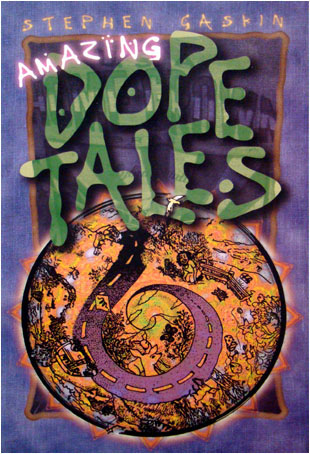
Stephen Gaskin is one of relatively few individuals to successfully build
something enduring from the ideas and experiences of the original
Haight-Ashbury era. An ex-marine and well-educated student and later teacher
at SF State, he was better prepared than most acidheads to observe and
understand what was going on in the early freak days. In 1972 he set off
with several busloads of hippies to establish 'The
Farm' in Tennessee, one of the most famous and long-lasting (it's still
around) experiments in communal living. He also headed up the Farm Band,
whose first LP is an acidrock classic, and went on lecture tours around the
USA.
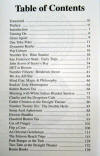
"Amazing Dope Tales" is pretty much what the title says -- a series of
anecdotes from Ground Zero of the LSD-fuelled counterculture, meaning San
Francisco circa 1965-67. Gaskin writes well in a natural, slightly
beat-inspired style, and offers lots of wry and funny observations on people
and the games they play -- especially when tripping. Apart from adding a
vital piece to the early SF puzzle, this is one of a surprisingly few books
that actually describes what the acid trips were like in those days -- in a
detailed, hour-by-hour fashion. Trip reports can be boring, but thanks to
Gaskin's condensed style and astute judgment, we get only the most vital
parts. I experienced actual flashbacks when reading some of the chapters. In addition to the power games and
strange habits that some of the characters engage in, substantial space is
spent on group LSD experiences such as telepathy, which again is something
hardly ever mentioned in the usual hallucinogen history books or Haight
chronicles. There are also some peyote stories.
This is a 1999 reprint from the 1980 original, with two new forewords. 138
pages, no images.
The Peyote Cult by
Weston La Barre, 4th edition (1975)
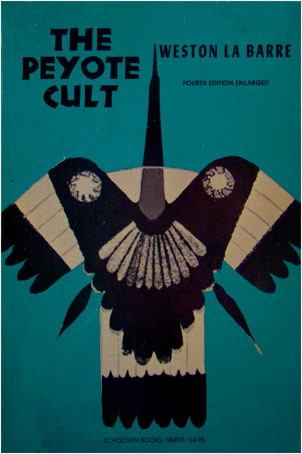
First published back in 1938, "The Peyote Cult" remains, as far as I know,
the standard academic work on Native American peyotism. Weston La Barre was
an old school anthropologist who originally wrote this as a Yale University
dissertation. Several editions followed, prompted at least in part by the
increased interest in the field, both academic and popular. This fourth and
last edition opens with a surprisingly harsh and emotional attack on the
modern-day espousers of peyote use, including beatniks, hippies, Tim Leary
and Carlos Castaneda. This odd foreword sounds like an aging professor
telling uneducated punks to get off his lawn.

Fortunately, the actual book is less myopic and more balanced. In fact, La
Barre demonstrates in an exemplary fashion how a conventional academic study
should be written. The scientific language flows by in a steady, unemotional
way, which contrasts nicely with the unorthodox subject. Covering the
earliest documented days of peyote use among indigenous tribes in Mexico
(which goes back to pre-Columbian days), the focus then follows peyote's
spread via Rio Grande tribes and upwards among the dozens of Native American
tribes on the North American plains (mainly during the late 19th century).
La Barre is an anthropologist, which means that he takes a lot of interest
in things like details of ritual, the diffusion of rituals and peyote usage,
and the influence of external factors (earlier mescal bean cults; modern
Christian evangelism, etc). The chapters that describe the ritual elements
and paraphernalia in great detail may seem somewhat dull, although it's
interesting to learn that La Barre's documentation is so precise that some
Native American groups used his book as a guide. The content of the peyote
experience, for the individual and the tribe, is covered to some extent, but
is not the focus of this anthropologic-ethnographic study.
However, the sections successively added in the later editions move away
from the details of ritual and cover several areas of more immediate
hallucinogenic concern. La Barre describes and comments upon recent
research, praises and criticizes his colleagues and various laymen (like
Aldous Huxley), and also finds room to write an excellent summary of the
early Harvard research of Leary and Alpert. LSD and psilocybin are
discussed, along with some valuable thoughts on the shamanic use of
hallucinogens. Somewhat surprising for a seemingly conservative academic, La
Barre whole-heartedly embraces the idea that hallucinogenic drugs were a
vital part of pre-historic shamanism, and suggests that the more we learn,
the more fundamental this coupling appears. This line of thought,
popularized in more recent times by people like Terence McKenna, was
undoubtedly controversial at the time (early 1970s), and goes directly
against Mircea Eliade's view that shamanic use of "narcotics" reflected
later, decadent forms of shamanism. Today, most would probably argue that
Eliade was wrong (to me his view seems more like an illogical, un-scientific
case of politic correctness); it's amusing to see the anti-hippie La Barre
express the exact same view as the better read hippies. In another
ahead-of-his-time critique, La Barre denounces Carlos Castaneda, who at this
time was at the height of his fame, inspiring many thousands of plant-eating
hippies that his stories were "real" and grounded in anthropologic research.
Once again, history has proven La Barre right, as Castaneda (and to some
degree a few of his academic colleagues), have been exposed as if not an
outright
charlatan, then definitely not a serious researcher.
There are also some chapters concerning peyote legislation, an issue of
great importance to the Native American Church, which already in the 1970s
counted more than 200,000 members. La Barre and some of his Ivy League
colleagues repeatedly defended and explicated the religious right of the
Native Americans to use peyote, which has been credited as a revitalizing
and reuniting traditional force among the increasingly acculturated tribes.
This battle has generally been successful.
While La Barre's original 1938 dissertation is impressive and will teach the
reader a lot about Native Americans along with the peyote religion, the
sections that form the later editions (about 100 pages) may be the most
useful to a non-academic, hallucinogen-inclined reader. 300 pages in total,
some black and white illustrations.
Hallucinogens
And Shamanism, edited by Michael Harner (1973)
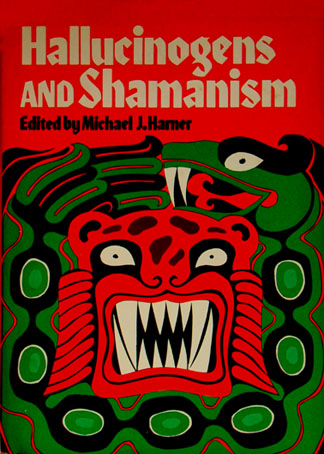
While a somewhat uneven and not overly impressive work by conventional
academic standards, this collection of essays became quite influential and
should be considered a genre classic today. The book was one of the first to
explore the link between modern anthropology and hallucinogenic drug use, a
field which in subsequent decades would become increasingly important.
Edited by Harner, already an experienced anthropologist, the volume contains
10 essays that deal primarily with use of ayahuasca (yage) and mushrooms in
Latin American cultures. Harner himself also contributes a very interesting
article about the use of psychoactive compounds within European witchcraft,
another area where much research and insight would follow in more recent
years.

Michael Harner was one of the first Western researchers to drink ayahuasca
(among the jivaro/shuar tribe in the early 1960s), and his unusually clear
and detailed description of his powerful journey has been quoted many times.
It's present only in an abbreviated form in this volume (one of Harner's
earlier works features a longer description), but any ayahuasca student
should still find Harner's two pieces here very useful. The other contributors
cover the aboriginal and mestizo use of hallucinogens from anthropological
and sociological perspectives. Special
mention must be made of Henry Munn's unusual essay about psilocybine
mushroom rituals in Mexico. Speaking as a disciple and advocate more than a
scientist, some or maybe all of this breathless report appears to have been
written under the influence, which may be appropriate since the title is
"Mushrooms Of Language". Hence, intense descriptions of fairly mundane
shroom rites are spiced up with obviously psychedelicized phrases like
"...the significance of existence that signifies with signs by the action of
speaking the experience of existence". Despite (or maybe due to) its
unorthdox and somewhat chaotic nature, this 1973 article may have influenced
Terence McKenna, as traces of some of McKenna's key ideas can be found with
Munn, such as the notion of the mushroom as the Logos.
Another observation I found interesting was Kensinger's and Naranjo's
remarks that the Western semantic notion of a hallucinogenic experience as a
"trip" and the wish "to have a good trip" has its exact counterpart in the
native languages of Amazon tribes such as the Casinahua.
Michael Harner would continue to explore the relationship between indigenous
use of hallucinogens, ancient shamanism, and modern western society, and
wrote a non-academic study The Way Of The Shaman (1980), which has
become a dominating influence on the neo-shamanistic movement (Harner's
specific model is called core shamanism) that began in the mid '80s and has
spread among new generations around the world.
The original hardcover edition of Hallucinogens And Shamanism can be
found without too much effort. Some black & white images, 200pp.
The Use
Of LSD In Psychotherapy -- Transactions Of A Conference On d-Lysergic
Acid Diethylamide (LSD-25), edited by Harold A Abramson, M.D.
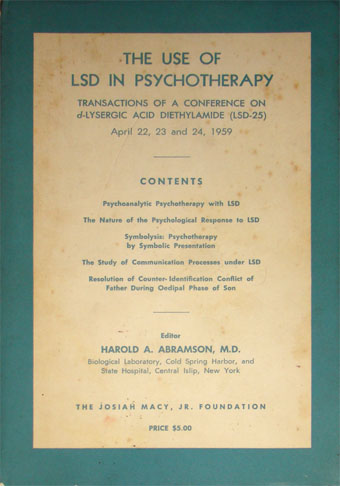
This is a edited transcript of a few lengthy roundtable discussions among
two dozen psychiatrists and psychologists, as part of a medical conference.
As such it is similar to the Louis Cholden volume from 1956 presented
above, but here three years have
passed, and the approach to LSD among professionals had changed
considerably. While the idea of acid as a 'wonder-drug' still is put forth
with some energy and enthusiasm, the knowledge and understanding of its
actions seems even more laden with confusion than before. Abram Hoffer is
able to report clear-cut success stories and established models for handling
LSD therapy from his renowned work with Humphry Osmond in Saskatchewan.
Similarly, the British pioneer Sandison returns from the 1956 conference and
again displays substantial experience and sound knowledge. A Dutch
researcher discusses some fairly radical modes of treatment of various
disorders, and throughout the debates, interesting observations and
successful therapies are reported.

The psychotomimetic paradigm, wherein LSD was thought to be useful as a
'model psychosis' and particularly applicable for schizophrenics, had been
more or less abandoned by specialists at this time, and most of the success
stories seem to stem from treatment of specific ailments such as alcoholism
or compulsive behavior, as well as within conventional psycho-therapy. In that
sense, the psychiatrist-psychologist branch were approaching a realistic view
of the use for LSD-25, yet the unpredictability, the tendency towards
religious and metaphysical experiences, the lack of precise
psycho-pharmacological data, and the poor understanding of the workings of
consciousness, still created an overriding sense of bewilderment. They know
they have something that seems to work wonders at times, but they don't understand it at all.
From the perspective of the 2000s this makes for rather entertaining and
charming reading, and I found this volume at least as interesting as the
1956 counterpart. The objectified view of the patients that the shrinks
have, and the carefree way in which experiments with strong hallucinogens
are conducted would undoubtedly cause an uproar today. The last chapter contains a lengthy transcript of a neurotic-narcissist patient on LSD, and is rather troubling
reading, until the acid therapy facilitates a self-insight breakthrough into
his problem complex. The book contains a number of intriguing tables of research
data, as well as some drawings by psychiatric patients under LSD. Never
reprinted, and somewhat difficult to find today. 300p.
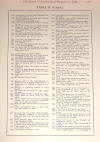
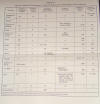
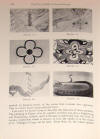
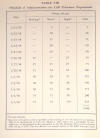
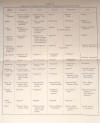
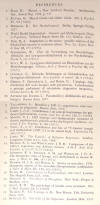
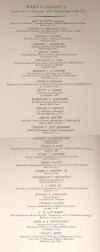
Hallucinogenic Plants Of
North America, by Jonathan Ott (1976)
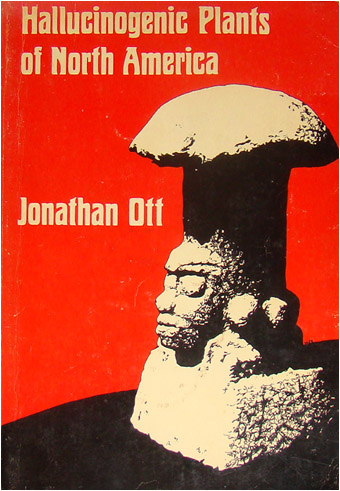
Jonathan Ott is one of the leading names in psychedelic (or 'entheogenic',
the term he prefers) research today, and has published a string of books
that mix deep knowledge of chemistry and ethnobotany with more free-form
contents, such as poetry. This volume from 1976 was his first published
work, facilitated with support from heavy names like Gordon Wasson and
Richard Evans-Schultes; a support necessary not least because Ott was an
auto-didact and didn't have the formal academic credentials of most
hallucinogen researchers.
"Hallucinogenic Plants Of North America" is a slender volume that documents in the form of a traditional flora a variety of plants found on
the North American continent. Cacti, various mushrooms, and a few plants
such as Datura are presented with technical names and descriptions, and
short histories of usage (the latter somewhat anecdotal and much too
brief). Today the volume of known hallucinogens in the region is much larger
than Ott's scope, which does not include the DMT-containing prairie grass,
as an example. In addition, many entheogenic plants have been introduced
into the USA in recent decades, for the express purpose of psychedelic use.
Thus, this book is only moderately useful today, and Ott's own later works
are more relevant. The section of 28 color photos of plants
(mostly mushrooms) is nice to look at, though.
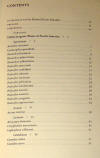
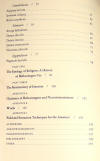
Much like how the McKenna brothers inserted a bit of personal speculation
into their otherwise purely technical mushroom grower's guide from the same time, Ott
provides two sections not directly related to his botanical effort. A
'history of hallucinogen use' covers mostly familiar ground, and leans too
heavily on Gordon Wasson, but is still an interesting read with a few
intriguing observations. The section about 'the biochemistry of emotion'
explains in full how brain chemistry works and details the workings of
axons, synaptic gaps and neurotransmitters. This info is usually only given
in summary in psychedelic literature, and thus it's a useful if somewhat
challenging chapter. Appendices contain more chemical data, as well as
glossaries, and some pages on field extraction techniques for would-be
psilocybin hunters.
The tone of the writing is somewhat uneven and at times naive and trapped in
zeitgeist, but I found this book enjoyable in its unassuming way. This
review refers to the revised edition from 1979, but a quick comparison
between this and the 1976 edition indicated no substantial differences.
|
